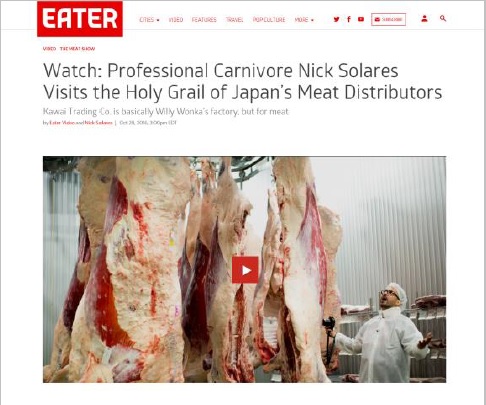

Written by Shigenobu Nakajima
Photo by Shuhei Fujita
The National Competitive Exhibition of Wagyu (as it is commonly called Zenkyo) was held in Miyagi Prefecture for 5 days, from September 7th to 11th. The "Wagyu Olympics" are held once every five years, and each time 500 producers of Wagyu beef from all over Japan gather. This year, Olive-fed beef from Kagawa Prefecture also participated in the event. To observe this event, New Yorker Nick Solares came to Japan for the second time. I interviewed Nick, who went back to the city from Miyagi.
His first encounter with Olive-fed beef dates back to several years ago, when Kagawa Prefecture held a tasting event in New York for Olive-fed beef. It was an event in which journalists and the media tasted Olive-fed beef. One of the people who participated in this event was Nick.
Last year, Kagawa Prefecture invited Nick and a Michelin chef to the prefecture to look at a site which was raising olive-fed cattle. "I ate Olive-fed beef in Takamatsu City, and was also guided around the beautiful areas of Shodo Island and Toshima. I was able to see the cattle being raised on an island where there is still an elegance of the past." After visiting the cattle farm, he also visited a meat processing plant, owned by the meat company "Kawai", in Takamatsu City. Nick was very interested in the fact that on an island with a traditional atmosphere, there was a processing factory which was equipped with the latest equipment. However, he was even more impressed with the artisan's craftsmanship during the process of deboning the carcass of the cow and preparing the meat.
According to Nick, in the case which "a company has the latest technology", more than the technology, it means that the products can be shipped out more quickly. The word "state-of-the-art technology" is used to describe the speed quality of an item. "However, in Kawai, in order to provide better meat, the skill of an artisan was used in a factory where they also had the latest technology available. By watching the artisan cut the Olive-fed beef using a special cutting sword, I was able to learn another reason why the beef is so delicious," said Nick.

<< Nick Solares Profile >>
Twelve years ago, he entered the spotlight with a food blog called "EATER New York", which he started as a hobby.
Currently, while continuing to work as a food writer, he also hosts a channel, called "The Meat Show", which specializes in meat.

The movie of Nick's visit to Kawai Company - The Meat Show -

Now, for this year. Nick confessed that he was happy to hear that Olive-fed beef won first place in the fat category. "I've always wanted to brag about it, as I've eaten all kinds of meat from around the world. However, there are flavors that Olive-fed beef has that I have never experienced before. I was able to confirm my feelings from the win," Nick said as he smiled.
In recent years, there are countries that raise "WAGYU" outside of Japan. I asked Nick what he thought about this. "In my opinion, beef called "Wagyu" cannot be raised outside of Japan. Wagyu-cross cattle can be bred artificially, or in a new way. However, Japanese-bred Wagyu and "WAGYU" have a quite different meaning." Nick compared the difference between Japanese-bred Wagyu and "WAGYU" to champagne. Champagne is made in the Champagne region of France. Even if it is made using the exact same recipe, anything produced outside of the Champagne region is called sparkling wine. "However, there are people who call their beverage champagne even though it was made outside of the Champagne region, which is the same thing that is happening in the world of Wagyu right now," Nick pointed out. "A cow which is raised by eating olive feed is a special product of Kagawa and is Olive-fed beef. It is raised using a special breeding method unique to Kagawa. This is the greatest feature of Olive-fed beef."
Nick urges people who are interested in food to eat the real thing. They will realize the difference also. Wealthy people and foodies are tending to lean more and more towards artisan foods and the demand for these foods are increasing. Nick used the word artisan to mean genuine, handmade craftsmanship. I asked if the price would become a bottleneck when exporting real Wagyu beef. "Delicious Olive-fed beef is something that should be enjoyed in small quantities instead of large quantities. If Olive-fed beef, which is raised with tender care, is exported, it will of course be expensive. If that is understood, then customers will think it's a suitable price and will buy it. Olive-fed beef, being processed by craftsman from technologically strong companies such as Kawai, I think it will certainly be able to be distributed overseas. I can confidently say that Olive-fed beef is a pride of Japan."
The day when these pride of Japan will be exported to New York and available in restaurants is coming soon. What kind of impression of Olive-fed beef will New Yorkers have after tasting it? What will they think is different about it than the Wagyu they have eaten so far? Will they also become fans of Olive-fed beef like Nick? My interest will not run out.